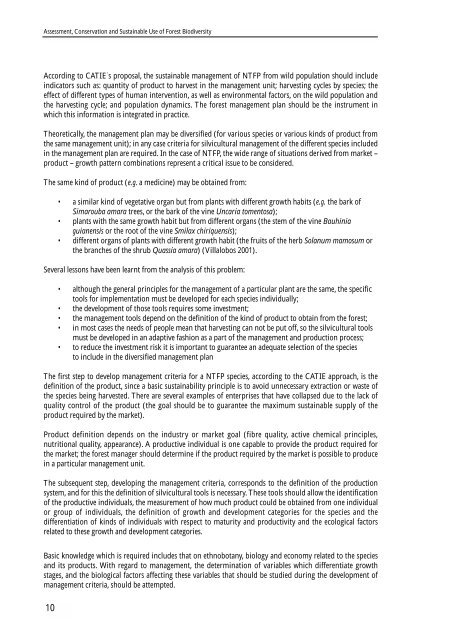Assessment, Conservation and Sustainable Use of Forest Biodiversity
Assessment, Conservation and Sustainable Use of Forest Biodiversity
Assessment, Conservation and Sustainable Use of Forest Biodiversity
Create successful ePaper yourself
Turn your PDF publications into a flip-book with our unique Google optimized e-Paper software.
<strong>Assessment</strong>, <strong>Conservation</strong> <strong>and</strong> <strong>Sustainable</strong> <strong>Use</strong> <strong>of</strong> <strong>Forest</strong> <strong>Biodiversity</strong><br />
According to CATIE´s proposal, the sustainable management <strong>of</strong> NTFP from wild population should include<br />
indicators such as: quantity <strong>of</strong> product to harvest in the management unit; harvesting cycles by species; the<br />
effect <strong>of</strong> different types <strong>of</strong> human intervention, as well as environmental factors, on the wild population <strong>and</strong><br />
the harvesting cycle; <strong>and</strong> population dynamics. The forest management plan should be the instrument in<br />
which this information is integrated in practice.<br />
Theoretically, the management plan may be diversified (for various species or various kinds <strong>of</strong> product from<br />
the same management unit); in any case criteria for silvicultural management <strong>of</strong> the different species included<br />
in the management plan are required. In the case <strong>of</strong> NTFP, the wide range <strong>of</strong> situations derived from market –<br />
product – growth pattern combinations represent a critical issue to be considered.<br />
The same kind <strong>of</strong> product (e.g. a medicine) may be obtained from:<br />
• a similar kind <strong>of</strong> vegetative organ but from plants with different growth habits (e.g. the bark <strong>of</strong><br />
Simarouba amara trees, or the bark <strong>of</strong> the vine Uncaria tomentosa);<br />
• plants with the same growth habit but from different organs (the stem <strong>of</strong> the vine Bauhinia<br />
guianensis or the root <strong>of</strong> the vine Smilax chiriquensis);<br />
• different organs <strong>of</strong> plants with different growth habit (the fruits <strong>of</strong> the herb Solanum mamosum or<br />
the branches <strong>of</strong> the shrub Quassia amara) (Villalobos 2001).<br />
Several lessons have been learnt from the analysis <strong>of</strong> this problem:<br />
• although the general principles for the management <strong>of</strong> a particular plant are the same, the specific<br />
tools for implementation must be developed for each species individually;<br />
• the development <strong>of</strong> those tools requires some investment;<br />
• the management tools depend on the definition <strong>of</strong> the kind <strong>of</strong> product to obtain from the forest;<br />
• in most cases the needs <strong>of</strong> people mean that harvesting can not be put <strong>of</strong>f, so the silvicultural tools<br />
must be developed in an adaptive fashion as a part <strong>of</strong> the management <strong>and</strong> production process;<br />
• to reduce the investment risk it is important to guarantee an adequate selection <strong>of</strong> the species<br />
to include in the diversified management plan<br />
The first step to develop management criteria for a NTFP species, according to the CATIE approach, is the<br />
definition <strong>of</strong> the product, since a basic sustainability principle is to avoid unnecessary extraction or waste <strong>of</strong><br />
the species being harvested. There are several examples <strong>of</strong> enterprises that have collapsed due to the lack <strong>of</strong><br />
quality control <strong>of</strong> the product (the goal should be to guarantee the maximum sustainable supply <strong>of</strong> the<br />
product required by the market).<br />
Product definition depends on the industry or market goal (fibre quality, active chemical principles,<br />
nutritional quality, appearance). A productive individual is one capable to provide the product required for<br />
the market; the forest manager should determine if the product required by the market is possible to produce<br />
in a particular management unit.<br />
The subsequent step, developing the management criteria, corresponds to the definition <strong>of</strong> the production<br />
system, <strong>and</strong> for this the definition <strong>of</strong> silvicultural tools is necessary. These tools should allow the identification<br />
<strong>of</strong> the productive individuals, the measurement <strong>of</strong> how much product could be obtained from one individual<br />
or group <strong>of</strong> individuals, the definition <strong>of</strong> growth <strong>and</strong> development categories for the species <strong>and</strong> the<br />
differentiation <strong>of</strong> kinds <strong>of</strong> individuals with respect to maturity <strong>and</strong> productivity <strong>and</strong> the ecological factors<br />
related to these growth <strong>and</strong> development categories.<br />
Basic knowledge which is required includes that on ethnobotany, biology <strong>and</strong> economy related to the species<br />
<strong>and</strong> its products. With regard to management, the determination <strong>of</strong> variables which differentiate growth<br />
stages, <strong>and</strong> the biological factors affecting these variables that should be studied during the development <strong>of</strong><br />
management criteria, should be attempted.<br />
10

















